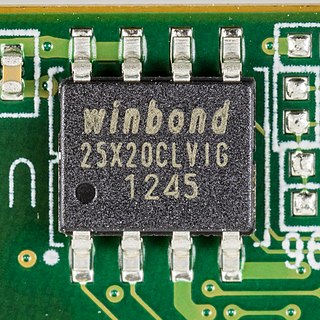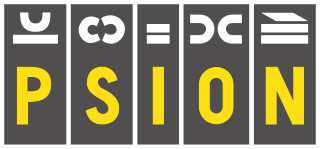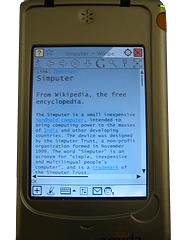
A Linux distribution is an operating system made from a software collection that includes the Linux kernel and often a package management system. Linux users usually obtain their operating system by downloading one of the Linux distributions, which are available for a wide variety of systems ranging from embedded devices and personal computers to powerful supercomputers.

An operating system (OS) is system software that manages computer hardware and software resources, and provides common services for computer programs.

Palm OS was a mobile operating system initially developed by Palm, Inc., for personal digital assistants (PDAs) in 1996. Palm OS was designed for ease of use with a touchscreen-based graphical user interface. It is provided with a suite of basic applications for personal information management. Later versions of the OS have been extended to support smartphones. The software appeared on the company's line of Palm devices while several other licensees have manufactured devices powered by Palm OS.

In computing, firmware is a specific class of computer software that provides the low-level control for a device's specific hardware. Firmware, such as the BIOS of a personal computer, may contain basic functions of a device, and may provide hardware abstraction services to higher-level software such as operating systems. For less complex devices, firmware may act as the device's complete operating system, performing all control, monitoring and data manipulation functions. Typical examples of devices containing firmware are embedded systems, home and personal-use appliances, computers, and computer peripherals.

Psion PLC was a designer and manufacturer of mobile handheld computers for commercial and industrial uses. The company was headquartered in London, England, with major operations in Mississauga, Ontario, Canada, and other company offices in Europe, the United States, Asia, Latin America, and the Middle East. It was a public company listed on the London Stock Exchange and was once a constituent of the FTSE 100 Index.

An embedded system is a computer system—a combination of a computer processor, computer memory, and input/output peripheral devices—that has a dedicated function within a larger mechanical or electronic system. It is embedded as part of a complete device often including electrical or electronic hardware and mechanical parts. Because an embedded system typically controls physical operations of the machine that it is embedded within, it often has real-time computing constraints. Embedded systems control many devices in common use. In 2009, it was estimated that ninety-eight percent of all microprocessors manufactured were used in embedded systems.

Palm is a line of personal digital assistants (PDAs) and mobile phones developed by California-based Palm, Inc., originally called Palm Computing, Inc. Palm devices are often remembered as "the first wildly popular handheld computers," responsible for ushering in the smartphone era.
L4 is a family of second-generation microkernels, used to implement a variety of types of operating systems (OS), though mostly for Unix-like, Portable Operating System Interface (POSIX) compliant types.
The MicroBlaze is a soft microprocessor core designed for Xilinx field-programmable gate arrays (FPGA). As a soft-core processor, MicroBlaze is implemented entirely in the general-purpose memory and logic fabric of Xilinx FPGAs.
In Linux systems, initrd is a scheme for loading a temporary root file system into memory, to be used as part of the Linux startup process. initrd and initramfs refer to two different methods of achieving this. Both are commonly used to make preparations before the real root file system can be mounted.

In computer science, hierarchical protection domains, often called protection rings, are mechanisms to protect data and functionality from faults and malicious behavior.

Linux is a family of open-source Unix-like operating systems based on the Linux kernel, an operating system kernel first released on September 17, 1991, by Linus Torvalds. Linux is typically packaged as a Linux distribution (distro), which includes the kernel and supporting system software and libraries, many of which are provided by the GNU Project. Many Linux distributions use the word "Linux" in their name, but the Free Software Foundation uses and recommends the name "GNU/Linux" to emphasize the use and importance of GNU software in many distributions, causing some controversy.
Swami Manohar, otherwise known as Manohar Swaminathan, is a co-founder and the CEO of PicoPeta Simputers Pvt. Ltd. He completed his undergraduate program in Electronics and Communication Engineering in Government College of Technology, Coimbatore during which he was a part of a campus team that designed an Electronic Voting machine in the year 1981, which was actually the first designed in India. After obtaining his PhD in Computer Science from Brown University he was a faculty at the University of North Carolina for two years and then was at the Indian Institute of Science (IISc), Bangalore, between 1990 and 2005. He was on the faculty of the department of Computer Science and Automation (CSA) and the Supercomputer Education and Research Center (SERC) at the Institute. He has been a visiting faculty at Columbia University, University of Missouri and the University of Texas. While at IISc, he co-invented the Simputer, was awarded the Dewang Mehta Award for Innovation in IT, and pioneered the faculty entrepreneurship activity at IISc, which has since catalyzed similar activity in IITs and other educational institutes in India. He co-founded Strand Life Sciences, and String Labs, the first academic incubating company in India.
A virtual security appliance is a computer appliance that runs inside virtual environments. It is called an appliance because it is pre-packaged with a hardened operating system and a security application and runs on a virtualized hardware. The hardware is virtualized using hypervisor technology delivered by companies such as VMware, Citrix and Microsoft. The security application may vary depending on the particular network security vendor. Some vendors such as Reflex Systems have chosen to deliver Intrusion Prevention technology as a Virtualized Appliance, or as a multifunctional server vulnerability shield delivered by Blue Lane. The type of security technology is irrelevant when it comes to the definition of a Virtual Security Appliance and is more relevant when it comes to the performance levels achieved when deploying various types of security as a virtual security appliance. Other issues include visibility into the hypervisor and the virtual network that runs inside.

ELinOS is a commercial development environment for embedded Linux. It consists of a Linux distribution for the target embedded system and development tools for a development host computer. The development host computer usually is a standard desktop computer running Linux or Windows. The Linux system and the application software for the target device are both created on the development host.

The Skytone Alpha-400 is a Linux-based low-cost netbook with a 7 in 800×480 LCD screen, introduced in 2008. Its measurements (length×width×depth) are 210×140×32 mm and it weighs 0.65 kg.

Bharat Operating System Solutions is an Indian Linux distribution based on Debian, with Its latest stable version is 9.0 ("Urja") which was released in February 2021.

The kernel is a computer program at the core of a computer's operating system and generally has complete control over everything in the system. The kernel is also responsible for preventing and mitigating conflicts between different processes. It is the portion of the operating system code that is always resident in memory and facilitates interactions between hardware and software components. A full kernel controls all hardware resources via device drivers, arbitrates conflicts between processes concerning such resources, and optimizes the utilization of common resources e.g. CPU & cache usage, file systems, and network sockets. On most systems, the kernel is one of the first programs loaded on startup. It handles the rest of startup as well as memory, peripherals, and input/output (I/O) requests from software, translating them into data-processing instructions for the central processing unit.
zram, formerly called compcache, is a Linux kernel module for creating a compressed block device in RAM, i.e. a RAM disk with on-the-fly disk compression. The block device created with zram can then be used for swap or as general-purpose RAM disk. The two most common uses for zram are for the storage of temporary files and as a swap device. Initially, zram had only the latter function, hence the original name "compcache".
Besides the Linux distributions designed for general-purpose use on desktops and servers, distributions may be specialized for different purposes including computer architecture support, embedded systems, stability, security, localization to a specific region or language, targeting of specific user groups, support for real-time applications, or commitment to a given desktop environment. Furthermore, some distributions deliberately include only free software. As of 2015, over four hundred Linux distributions are actively developed, with about a dozen distributions being most popular for general-purpose use.













